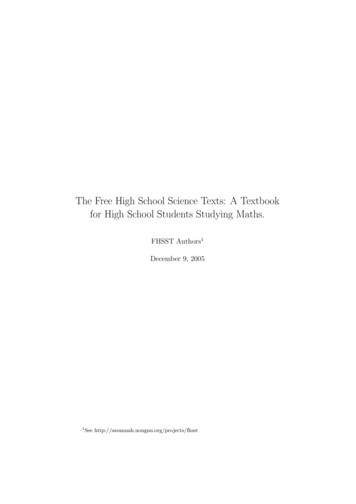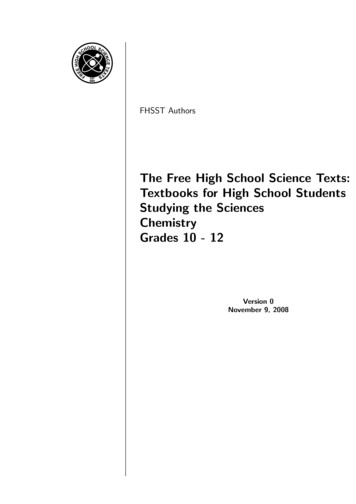
Transcription
The Free High School Science Texts: A Textbookfor High School Students Studying Maths.FHSST Authors1December 9, 20051See http://savannah.nongnu.org/projects/fhsst
c 2003 “Free High School Science Texts”Copyright Permission is granted to copy, distribute and/or modify this document under the terms of the GNU Free Documentation License, Version 1.2 or any later version published by the Free Software Foundation; with no Invariant Sections, no Front-Cover Texts, and noBack-Cover Texts. A copy of the license is included in the sectionentitled “GNU Free Documentation License”.i
ContentsIMaths11 Numbers1.1 Letters and Arithmetic . . . . . . . . . .1.1.1 Adding and Subtracting . . . . .1.1.2 Negative Numbers . . . . . . . .1.1.3 Brackets . . . . . . . . . . . . . .1.1.4 Multiplying and Dividing . . . .1.1.5 Rearranging Equations . . . . . .1.1.6 Living Without the Number Line1.2 Types of Real Numbers . . . . . . . . .1.2.1 Integers . . . . . . . . . . . . . .1.2.2 Fractions and Decimal numbers .1.2.3 Rational Numbers . . . . . . . .1.3 Exponents . . . . . . . . . . . . . . . . .1.4 Surds . . . . . . . . . . . . . . . . . . .1.4.1 Like and Unlike Surds . . . . . .1.4.2 Rationalising Denominators . . .1.4.3 Estimating a Surd . . . . . . . .1.5 Accuracy . . . . . . . . . . . . . . . . .1.5.1 Scientific Notation . . . . . . . .1.5.2 Worked Examples . . . . . . . .1.5.3 Exercises . . . . . . . . . . . . .34456678999101416171818192020212 Patterns in Numbers2.1 Sequences . . . . . . . . . . . . . . . . . .2.1.1 Arithmetic Sequences . . . . . . .2.1.2 Quadratic Sequences . . . . . . . .2.1.3 Geometric Sequences . . . . . . . .2.1.4 Recursive Equations for sequences2.1.5 Extra . . . . . . . . . . . . . . . .2.2 Series (Grade 12) . . . . . . . . . . . . . .2.2.1 Finite Arithmetic Series . . . . . .2.2.2 Finite Squared Series . . . . . . . .2.2.3 Finite Geometric Series . . . . . .2.2.4 Infinite Series . . . . . . . . . . . .2.3 Worked Examples . . . . . . . . . . . . .2.4 Exercises . . . . . . . . . . . . . . . . . .2222232526272828293232333336ii
3 Functions3.1 Functions and Graphs . . . . . . . . . . .3.1.1 Variables, Constants and Relations3.1.2 Definition of a Function (grade 12)3.1.3 Domain and Range of a Relation .3.1.4 Example Functions . . . . . . . . .3.2 Exponentials and Logarithms . . . . . . .3.2.1 Exponential Functions . . . . . . .3.2.2 Logarithmic Functions . . . . . . .3.3 Extra . . . . . . . . . . . . . . . . . . . .3.3.1 Absolute Value Functions . . . . .4 Numerics4.1 Optimisation . . . . . . . . . . . . . . . . . . .4.1.1 Linear Programming . . . . . . . . . . .4.2 Gradient . . . . . . . . . . . . . . . . . . . . . .4.3 Old Content (please delete when finished) . . .4.3.1 Problems . . . . . . . . . . . . . . . . .4.3.2 Maximising or Minimising the Objective.3838394041424647474949. . . . . . . . . . . . . . . . . . . . . . . . . .Function.53535557575759.Essay 1 : Differentiation in the Financial World5 Differentiation5.1 Limit and Derivative . . . . . . . .5.1.1 Gradients and limits . . . .5.1.2 Differentiating f (x) xn .5.1.3 Other notations . . . . . . .5.2 Rules of Differentiation . . . . . .5.2.1 Summary . . . . . . . . . .5.3 Using Differentiation with Graphs5.3.1 Finding Tangent Lines . . .5.3.2 Curve Sketching . . . . . .5.4 Worked Examples . . . . . . . . .5.5 Exercises . . . . . . . . . . . . . .6 Geometry6.1 Polygons . . . . . . . . . . . . . . . . . . .6.1.1 Triangles . . . . . . . . . . . . . .6.1.2 Quadrilaterals . . . . . . . . . . .6.1.3 Other polygons . . . . . . . . . . .6.1.4 Similarity of Polygons . . . . . . .6.1.5 Midpoint Theorem . . . . . . . . .6.1.6 Extra . . . . . . . . . . . . . . . .6.2 Solids . . . . . . . . . . . . . . . . . . . .6.3 Coordinates . . . . . . . . . . . . . . . . .6.4 Transformations . . . . . . . . . . . . . .6.4.1 Shifting, Reflecting, Stretching and6.5 Stretching and Shrinking Graphs . . . . .6.6 Mixed Problems . . . . . . . . . . . . . .6.7 Equation of a Line . . . . . . . . . . . . .iii62.646464666767686868696974. . . . . . . . . . . . . . . . . . . . . . . . . . . . . . . . . . . . . . . . . . . . . . . . . . . . . . . . . . . . . . . . . . . . . . . . . . . . . . . . . . . . . . . . . . . . . . . . . . . . .Shrinking Graphs:. . . . . . . . . . . . . . . . . . . . . . . . . . . . . . .767677787979798081828282848686.
6.8Circles . . . . . . . . . . . . . . . . . . . . . . . . .6.8.1 Circles & Semi-circles . . . . . . . . . . . .6.9 Locus . . . . . . . . . . . . . . . . . . . . . . . . .6.10 Other Geometries . . . . . . . . . . . . . . . . . . .6.11 Unsorted . . . . . . . . . . . . . . . . . . . . . . .6.11.1 Fundamental vocabulary terms . . . . . . .6.11.2 Parallel lines intersected by transversal lines.878788888888917 Trigonometry7.1 Syllabus . . . . . . . . . . . . . . . . . . . . . . . . . . . . . .7.1.1 Triangles . . . . . . . . . . . . . . . . . . . . . . . . .7.1.2 Trigonometric Formulæ . . . . . . . . . . . . . . . . .7.2 Radian and Degree Measure . . . . . . . . . . . . . . . . . . .7.2.1 The unit of radians . . . . . . . . . . . . . . . . . . . .7.3 Definition of the Trigonometric Functions . . . . . . . . . . .7.3.1 Trigonometry of a Right Angled Triangle . . . . . . .7.3.2 Trigonometric Graphs . . . . . . . . . . . . . . . . . .7.3.3 Secant, Cosecant, Cotangent and their graphs . . . . .7.3.4 Inverse trigonometric functions . . . . . . . . . . . . .7.4 Trigonometric Rules and Identities . . . . . . . . . . . . . . .7.4.1 Translation and Reflection . . . . . . . . . . . . . . . .7.4.2 Pythagorean Identities . . . . . . . . . . . . . . . . . .7.4.3 Sine Rule . . . . . . . . . . . . . . . . . . . . . . . . .7.4.4 Cosine Rule . . . . . . . . . . . . . . . . . . . . . . . .7.4.5 Area Rule . . . . . . . . . . . . . . . . . . . . . . . . .7.4.6 Addition and Subtraction Formulae . . . . . . . . . .7.4.7 Double and Triple Angle Formulae . . . . . . . . . . .7.4.8 Half Angle Formulae . . . . . . . . . . . . . . . . . . .7.4.9 ‘Product to Sum’ and ‘Sum to Product’ Identities . .7.4.10 Solving Trigonometric Identities . . . . . . . . . . . .7.5 Application of Trigonometry . . . . . . . . . . . . . . . . . . .7.5.1 Height and Depth . . . . . . . . . . . . . . . . . . . .7.5.2 Maps and Plans . . . . . . . . . . . . . . . . . . . . .7.6 Trigonometric Equations . . . . . . . . . . . . . . . . . . . . .7.6.1 Solution using CAST diagrams . . . . . . . . . . . . .7.6.2 Solution Using Periodicity . . . . . . . . . . . . . . . .7.6.3 Linear Triginometric Equations . . . . . . . . . . . . .7.6.4 Quadratic and Higher Order Trigonometric Equations7.6.5 More Complex Trigonometric Equations . . . . . . . .7.7 Summary of the Trigonomertic Rules and Identities . . . . . 1161171171181181191201221251261261271288 Solving Equations8.1 Linear Equations . . . . . . . . . . . . . . . . . . . . . . . .8.1.1 Introduction . . . . . . . . . . . . . . . . . . . . . .8.1.2 Solving Linear equations - the basics . . . . . . . . .8.1.3 Solving linear equations - Combining the basics in asteps . . . . . . . . . . . . . . . . . . . . . . . . . . .8.2 Quadratic Equations . . . . . . . . . . . . . . . . . . . . . .8.2.1 The Quadratic Function . . . . . . . . . . . . . . . .iv. . . . . . .few. . . . . . .130130130131133136136
8.2.28.38.48.58.68.78.8Writing a quadratic function in the formp)2 q. . . . . . . . . . . . . . . . . . . .8.2.3 What is a Quadratic Equation? . . . . . .8.2.4 Factorisation . . . . . . . . . . . . . . . .8.2.5 Completing the Square . . . . . . . . . . .8.2.6 Theory of Quadratic Equations . . . . . .Cubic Equations . . . . . . . . . . . . . . . . . .Exponential Equations . . . . . . . . . . . . . . .Trigonometric Equations . . . . . . . . . . . . . .Simultaneous Equations . . . . . . . . . . . . . .Inequalities . . . . . . . . . . . . . . . . . . . . .8.7.1 Linear Inequalities . . . . . . . . . . . . .8.7.2 What is a Quadratic Inequality . . . . . .8.7.3 Solving Quadratic Inequalities . . . . . .Intersections . . . . . . . . . . . . . . . . . . . . .9 Working with Data9.1 Statistics . . . . . . .9.2 Function Fitting . . .9.3 Probability . . . . . .9.4 Permutations and Tree9.5 Finance . . . . . . . .9.6 Worked Examples . .9.7 Exercises . . . . . . .II. . . . . . . . . . . . . . . .Diagrams. . . . . . . . . . . . . . . .f (x). . . . . . . . . . . . . . . . . . . . . . . . . . . . . a(x . . . . . . . . . . . . . . . . . . . . . . . . . . . . . . . . . . . . . . . . . . . . . . . . . . . . . . . . . . . . . . . . . . . . . . 152153153154154154.Old Maths10 Worked Examples10.1 Exponential Numbers . .10.2 series . . . . . . . . . . . .10.3 functions . . . . . . . . .10.3.1 Worked Examples:155.A GNU Free Documentation Licensev.156156166170186188
Part IMaths1
This book attempts to meet the criteria for the SA “Outcomes Based” syllabus of 2004. A few notes to authors:All “real world examples” should be in the context of HIV/AIDS, labourdisputes, human rights, social, economical, cultural, political and environmentalissues. Unless otherwise stated in the syllabus. Where possible, every sectionshould have a practical problem.The preferred method for disproving something is by counter example. Justification for any mathematical generalisations of applied examples is alwaysdesired.2
Chapter 1Numbers(NOTE: more examples and motivation needed. perhaps drop the proofs forexponents and surds?)A number is a way to represent quantity. Numbers are not something thatwe can touch or hold, because they are not physical. But you can touch threeapples, three pencils, three books. You can never just touch three, you can onlytouch three of something. However, you don’t need to see three apples in frontof you to know that if you take one apple away, that there will be two applesleft. You can just think about it. That is your brain representing the apples innumbers and then performing arithmetic on them.A number represents quantity because we can look at the world around usand quantify it using numbers. How many minutes? How many kilometers?How many apples? How much money? How much medicine? These are allquestions which can only be answered using numbers to tell us “how much” ofsomething we want to measure.A number can be written many different ways and it is always best to choosethe most appropriate way of writing the number. For example, the number “ahalf” may be spoken aloud or written in words, but that makes mathematicsvery difficult and also means that only people who speak the same language asyou can understand what you mean. A better way of writing “a half” is as afraction 12 or as a decimal number 0,5. It is still the same number, no matterwhich way you write it.In high school, all the numbers which you will see are called real numbers(NOTE: Advanced: The name “real numbers” is used because there aredifferent and more complicated numbers known as “imaginary numbers”, whichthis book will not go into. Since we won’t be looking at numbers which aren’treal, if you see a number you can be sure it is a real one.) and mathematiciansuse the symbol R to stand for the set of all real numbers, which simply means allof the real numbers. Some of these real numbers can be written in a particularway, but others cannot.This chapter will explain different ways of writing any number, and wheneach way of writing the number is best.(NOTE: This intro needs more motivation for different types of numbers,some real world examples and more interesting facts. Lets avoid the wholedifferent numeral systems though. maybe when we do the history edit nearrelease.)3
1.1Letters and ArithmeticThe syllabus requires: algebraic manipulation is governed by the algebra of the realnumbers manipulate equations (rearrange for y, expand a squared bracket)(NOTE: “algebra of the Reals”. why letters are useful. very simple example, like change from a shop. brackets, squared brackets, fractions, multiply topand bottom. rearranging. doing something to one side and the other.)When you add, subtract, multiply or divide two numbers, you are performingarithmetic 1 . These four basic operations ( , , , ) can be performed on anytwo real numbers.Since they work for any two real numbers, it would take forever to write outevery possible combination, since there are an infinite(NOTE: Advanced: wereally need to define what infinite means, nicely!) amount of real numbers! Tomake things easier, it is convenient to use letters to stand in for any number 2 ,and then we can fill in a particular number when we need to. For example, thefollowing equationx y z(1.1)can find the change you are owed for buying an item. In this equation, xrepresents the amount of change you should get, z is the amount you payed andy is the price of the item. All you need to do is write the amount you payedinstead of z and the price instead of y, your change is then x. But to be able tofind your change you will need to rearrange the equation for x. We’ll find outhow to do that just after we learn some more details about the basic operators.1.1.1Adding and SubtractingAdding, subtracting, multiplying and dividing are the most basic operationsbetween numbers but they are very closely related to each other. You canthink of subtracting as being the opposite of adding since adding a number andthen subtracting the same number will not change what you started with. Forexample, if we start with a and add b, then subtract b, we will just get back toa againa b b a(1.2)5 2 2 5(NOTE: rework these bits into the Negative Numbers section. it needs moreattention than we initially thought.) Subtraction is actually the same as addinga negative number. A negative number is a number less than zero. Numbersgreater than zero are called positive numbers. In this example, a and b arepositive numbers, but b is a negative numbera b a ( b)5 3 5 ( 3)1 Arithmetic2 Weis the Greek word for “number”will look at this in more detail in chapter 3.4(1.3)
It doesn’t matter which order you write additions and subtractions(NOTE:Advanced: This is a property known as associativity, which means a b b a),but it looks better to write subtractions to the right. You will agree that a blooks neater than b a, and it makes some sums easier, for example, mostpeople find 12 3 a lot easier to work out than 3 12, even though they arethe same thing.1.1.2Negative NumbersNegative numbers can be very confusing to begin with, but there is nothingto be afraid of. When you are adding a negative number, it is the same assubtracting that number if it were positive. Likewise, if you subtract a negativenumber, it is the same as adding the number if it were positive. Numbers areeither positive or negative, and we call this their sign. A positive number haspositive sign, and a negative number has a negative sign.(NOTE: number line here. subtraction is moving to left, adding is movingto the right. maybe something else about negative numbers?)Table 1.1 shows how to calculate the sign of the answer when you multiplytwo numbers together. The first column shows the sign of one of the numbers,the second column gives the sign of the other number, and the third columnshows what sign the answer will be. So multiplying a negative number bya -b -a b Table 1.1: Table of signs for multiplying two numbers.a positive number always gives you a negative number, whereas multiplyingnumbers which have the same sign always gives a positive number. For example,2 3 6 and 2 3 6, but 2 3 6 and 2 3 6.Adding numbers works slightly differently, have a look at Table 1.2. If youa -b -a b ?-Table 1.2: Table of signs for adding two numbers.add two positive numbers you will always get a positive number, but if you addtwo negative numbers you will always get a negative number. If the numbershave different sign, then the sign of the answer depends on which one is bigger.5
1.1.3BracketsIn equation (1.3) we used brackets3 around b. Brackets are used to show theorder in which you must do things. This is important as you can get differentanswers depending on the order in which you do things. For example(5 10) 20 70(1.4)5 (10 20) 150(1.5)whereasIf you don’t see any brackets, you should always do multiplications and divisions first and then additions and subtractions4 . You can always put your ownbrackets into equations using this rule to make things easier for yourself, forexample:a b c d (a b) (c d)5 10 20 4 (5 10) (20 4)1.1.4(1.6)Multiplying and DividingJust like addition and subtraction, multiplication and division are opposites ofeach other. Multiplying by a number and then dividing by the same numbergets us back to the start again:a b b a(1.7)5 4 4 5Sometimes you will see a multiplication of letters without the symbol,don’t worry, its exactly the same thing. Mathematicians are lazy and like towrite things in the neatest way possible.abc a b c(1.8)It is usually neater to write known numbers to the left, and letters to theright. So although 4x and x4 are the same thing(NOTE: Advanced: This isa property known as commutativity, which means ab ba), it looks better towrite 4x.If you see a multiplication outside a bracket like thisa(b c)(1.9)3(4 3)then it means you have to multiply each part inside the bracket by the numberoutsidea(b c)3(4 3) ab ac 3 4 3 3 12 9 33 Sometimes(1.10)people say “parenthesis” instead of “brackets”.and dividing can be performed in any order as it doesn’t matter. Likewise itdoesn’t matter which order you do addition and subtraction. Just as long as you do any before any .4 Multiplying6
unless you can simplify everything inside the bracket into a single term. In fact,in the above example, it would have been smarter to have done this3(4 3) 3 (1) 3(1.11)It can happen with letters too3(4a 3a) 3 (a) 3a(1.12)If there are two brackets multiplied by each other, then you can do it onestep at a time1.1.5(a b)(c d) a(c d) b(c d) ac ad bc bd(a 3)(4 d) a(4 d) 3(4 d) 4a ad 12 3d(1.13)Rearranging EquationsComing back to the example about change, which we wanted to solve earlier inequation (1.1)x y zTo recap your memory, z is the amount you (or a customer) payed for something,y is the price and you want to find x, the change. What you need to do isrearrange the equation so only x is on the left.You can add, subtract, multiply or divide both sides of an equation by anynumber you want, as long as you always do it to both sides. If you imagine anequation is like a set of weighing scales. (NOTE: diagram here.) If you wish tokeep the scales balanced, then when you add something to one side, you mustalso add something of the same weight to the other side.So for our example we could subtract y from both sidesx y z x y y z yx z y(1.14)so now we can find the change is the amount payed take away the price. Inreal life we can do this in our head, the human brain is very smart and can doarithmetic without even knowing it.When you subtract a number from both sides of an equation, it looks justlike you moved a positive number from one side and it became a negative onthe other, which is exactly what happened. Likewise if you move a multipliednumber from one side to the other, it looks like it changed to a divide. Thisis because you really just divided both sides by that number, and a numberdivided by itself is just 1a(5 c) 3aa a(5 c) 3a a1 (5 c) 3 15 c 3c 73 5 2(1.15)
However you must be careful when doing this, as it is easy to make mistakes.The following is the wrong thing to do5 .5a c 3a5 c6 3a a(1.16)Can you see why it is wrong? The reason why it is wrong is because we didn’tdivide the c part by a as well. The correct thing to do is5a c 3a5 c a 3c a1.1.6 (1.17)3 5 2Living Without the Number LineThe number line in (NOTE: ref when we do it) is a good way to visualise whatnegative numbers are, but it can get wery inefficient to use it every time youwant to add or subtract negative numbers. To keep things simple, we will writedown three rules that you should memorise. These rules will let you work outwhat the answer is when you add or subtract numbers which may be negativeand will also help you keep your work tidy and easier to understand.Signs Rule 1If you have an equation which has a negative number on the very far left, it canbe confusing. But it doesn’t matter where we put the negative number, as longas it is on the left of the equals sign(NOTE: this is confusing). If we move itmore to the right, it makes more sense as it just looks like subtracting a positivenumber. a b b a 5 10 10 5 5(1.18)This makes equations easier to understand. For example, a question like “Whatis 7 11?” looks a lot more complicated than “What is 11 7?”, even thoughthey are exactly the same question.Signs Rule 2When you have two negative numbers like 3 7, you can calculate the answer by simply adding together the numbers as if they were positive and thenremembering to put a negative sign in front. c d (c d) 7 2 (7 2) 95 The6 symbol says that this is incorrect as it means “not equal to”.8(1.19)
Signs Rule 3In section 1.1.2 we seen that the sign of two numbers added together dependson which one is bigger. This last rule tells us that all we need to do is take thesmaller number away from the larger one, and remember to put a negative signbefore the answer if the bigger number was subtracted to begin with. In thisequation, F is bigger than e.e F2 11 (F e) (11 2) 9(1.20)You can even combine these rules together, so for example you can use rule1 on 10 3 to get 3 10, and then use rule 3 to get (10 3) 7.Now you know everything there is to know about arithmetic. So try out yourskills on the exercises at the end of this chapter and ask your teacher for morequestions just like them. You can also try making up your own questions, solvethem and try them out on your classmates to see if you get the same answers.Practice is the only way to get good at maths.1.2Types of Real Numbers(NOTE: maybe more intro here, break up the chapter intro and put some here?)1.2.1IntegersThe natural numbers are all the numbers which you can use for counting0, 1, 2, 3, 4 . . .(1.21)These are the first numbers learnt by children, and the easiest to understand.Mathematicians use the symbol N to mean the set of all natural numbers. Thenatural numbers are a subset of the real numbers since every natural number isalso a real number.The integers are all of the natural numbers and their negatives. . . 4, 3, 2, 1, 0, 1, 2, 3, 4 . . .(1.22)Mathematicians use the symbol Z to mean the set of all integers. The integersare a subset of the real numbers, since every integer is a real number.(NOTE: possible analogy. whole fruit on a tree, if you eat some, its not aninteger anymore.)1.2.2Fractions and Decimal numbersA fraction is any kind of number divided by another number. There are severalways to write a number divided by another one, such as a b, a/b and ab . Thefirst way of writing a fraction is very hard to work with, so we will use only theother two. We call the number on the top, the numerator and the number onthe bottom the denominator. e.g.15numerator 1denominator 59(1.23)
The reciprocal of a fraction is the fraction turned upside down, in otherwords the numerator becomes the denominator and the denominator becomesthe numerator. A fraction times its reciprocal always equals 1 and can be writtenab 1ba(1.24)This is because dividing by a number is the same as multiplying by its reciprocal.A decimal number is a number which has an integer part and a fraction part.The integer and the fraction parts are separated by a decimal point, which iswritten as a comma in South Africa. Every real number can be written as adecimal. For example the number 3 14/100 can be written much more cleanlyas 3,14.All real numbers can be written as a decimal. However, some numberswould take a huge amount of paper (and ink) to write out in full! Some decimalnumbers will have a number which will repeat itself, such as 0,33333 . . . wherethere are an infinite number of 3’s. We can write this decimal value by using adot above the repeating number, so 0,3̇ 0,33333 . . . If there are two repeatingnumbers such as 0,121212 . . . then you can place dots6 on each of the repeatednumbers 0,1̇2̇ 0,121212 . . . These kinds of repeating decimals are calledrecurring decimals.(NOTE: should we have a table of, say, the 10 most common fractions?)1.2.3Rational NumbersThe syllabus requires: identify rational numbers convert between terminating or recurring decimals and their fractionalformA rational number is any number which can be written as a fraction withan integer on the top and an integer on the bottom (as long as the integeron the bottom is not zero) (NOTE: Advanced: This can be expressed in theform ab ; a, b Z; b 6 0 which means “the set of numbers ab when a and b areintegers”.).Mathematicians use the symbol Q to mean the set of all rational numbers.The set of rational numbers contains all numbers which can be written as terminating or repeating decimals. (NOTE: Advanced: All integers are rationalnumbers with denominator 1.)An irrational number is any real number that is not a rational number.When expressed as decimals these numbers can never be fully written out asthey have an infinite numberof decimal places which never fall into a repeating pattern, for example 2 1,41421356 . . ., π 3,14159265 . . . π is a Greekletter and is pronounced just like “pie”. We’ll mention more about π in chapter7.1.You can add and multiply rational numbers and still get a rational numberat the end, which is very useful. If we have 4 integers, a, b, c and d(NOTE:Advanced: This can be written formally as {a, b, c, d} Z because the symbol6 ora bar, like 0,1210
QZRFigure 1.1: Set diagram of all the real numbers R, the rational numbers Q andthe integers Z. The irrational numbers are the numbers not inside the set ofrational numbers. All of the integers are also rational numbers, but not allrational numbers are integers. (NOTE: possible question; where is N in thisdiagram?)means in and we say that a, b, c and d are in the set of integers.), then the rulesfor adding and multiplying rational numbers areca bdca bd ad bcbdacbd(1.25)(1.26)Two rational numbers ( ab and dc ) represent the same number if ad bc. Itis always best to simplify any rational number so that the denominator is assmall as possible. This can be achieved by dividing both the numerator and thedenominator by the same integer. For example, the rational number 1000/10000can be divided by 1000 on the top and the bottom, which gives 1/10. 23 of a8pizza is the same as 12. (NOTE: maybe a diagram.)You can also add rational numbers together by finding a lowest common denominator and then adding the numerators. Finding a lowest common denominator means finding the lowest number that both denominators are a f actor 7of. A factor of a number is an integer which evenly divides that number withoutleaving a remainder. The following numbers all have a factor of 33, 6, 9, 12, 15, 18, 21, 24 . . .and the following all have factors of 44, 8, 12, 16, 20, 24, 28 . . .The common denominators between 3 and 4 are all the numbers that appear inboth of these lists, like 12 and 24. The lowest common denominator of 3 and 4is the number that has both 3 and 4 as factors, which is 12.7 Somepeople say divisor instead of factor.11
For example, if we wish to add 34 23 , we first need to write both fractionsso that their denominators are the same by finding the lowest common denominator, which we know is 12. We can do this by multiplying 34 by 33 8 and 32 by443 2 4 3 3 3 2 4 4 3 3 43 3 2 4 4 3 3 489 12 129 8121712(1.27)Dividing by a rational number is the same as multiplying by it’s reciprocal,as long as neither the numerator nor the denominator is zero:aca dad . bdb cbc(1.28)A rational number may also be written as a proper fraction, which is thesum of an integer and a rational fraction.Ac bbb A A ccc(1.29)This notation has the advantage that you can readily tell the approximate sizeof the fraction, but has the disadvantage that A cb can be mistaken for A cbinstead of A cb . However, it can be used to help convert rational numbersinto decimals and vica-versa. A fraction is called an improper fraction if thenumerator is bigger than the denominator, meaning that it could be written asa proper fraction.Converting Decimals into Rational NumbersIf you recall from section 1.2.2 that a decimal numb
In high school, all the numbers which you will see are called real num-bers(NOTE: Advanced: The name \real numbers" is used because there are difierent and more complicated numbers known as \imaginary numbers", which this book will not go into. Since we won't be looking at numbers which aren't











